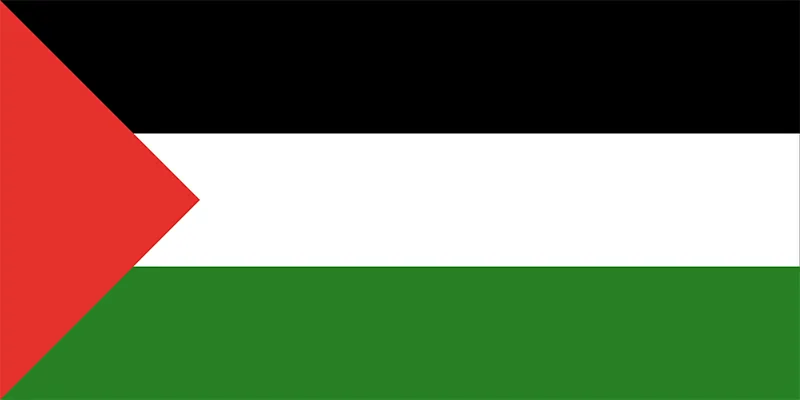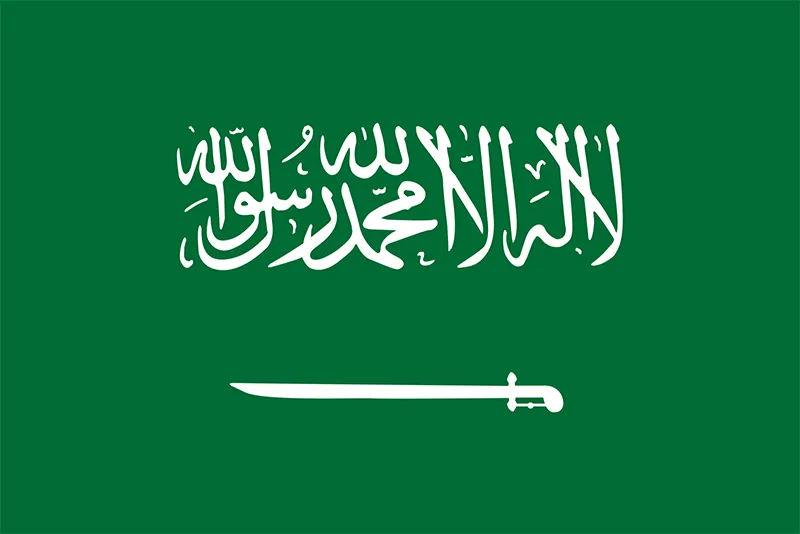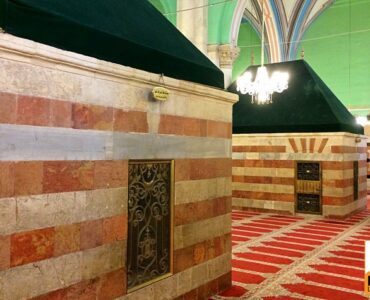The above enclosure, at the foot of Mount Uhud contains in the centre the graves of Hamza (رضي الله عنه), Abdullah bin Jasht (رضي الله عنه) and Mus’ab bin Umair (رضي الله عنه) who were all martyred in the Battle of Uhud. The rest of the martyrs of Uhud are buried behind this enclosure.
- Hamza ibn Abdul Muttalib was one of the finest huntsmen and greatest warrior of the Arabs. In the battle of Badr, he had killed many of the Qurayshi nobles and now he cut his way through their ranks like a mighty wave sweeping all before it. One of the Qurayshi nobles had a black slave called Wahshi from Abyssinia (present Ethiopia) who could use the javelin with great skill. Hind, the wife of Abu Sufyan, promised Wahshi freedom and his master Jubayr bin Mut’im also promised him the same as Hamza (رضي الله عنه) had killed his uncle in Badr. Wahshi prowled amongst the fighters until he saw Hamza (رضي الله عنه). He says, “I held my spear and balanced it well, then I aimed it. It entered into his abdomen and went out the other side. I waited until he was dead, then I took my spear and went to wait in the camp. I had no quarrel with anyone. I killed him only to be set free.” Wahshi later on in life became a Muslim and killed Musailimah, the imposter who claimed Prophethood after the demise of the Prophet Muhammad (ﷺ).
- When the tide of war turned towards the Quraysh, the women of Quraysh, led by Hind, whose brother, uncle and loved ones had been killed in Badr began to mutilate the Muslim dead. She particularly vented her fury on the body of Hamza (رضي الله عنه), cutting off his nose and ears, making a slit in his chest, taking out his liver, chewing it but unable to swallow it. The Prophet (ﷺ) was greatly grieved when he came upon the body of his beloved uncle. Years later, when Makkah lay open at his feet, he gave all its inhabitants, including Hind a free pardon. Hind subsequently accepted Islam.
- Mus’ab (رضي الله عنه) held the flag of Islam. When the Muslims on meeting defeat were dispersing in confusion, he held the flag and stood at his post like a rock. An enemy came and cut his hand with a sword, so that the flag might fall and the defeat might be accomplished. He at once took the flag in the other hand. The enemy then cut the other hand also. He held the flag to his bosom with the help of his bleeding arms. The enemy at last pierced his body with an arrow. He fell dead and, with him fell the flag that he had not allowed to fall while he was alive. Another Muslim ran and took over the flag. At the time of his burial, he had only one sheet to cover his body. This sheet was too short for his size. When it was drawn to cover the head, the feet would be exposed, and when it was drawn to cover the feet, the head would become uncovered. The Prophet (ﷺ) said: “Cover his head with the sheet, and his feet with the ‘Azkhar’ leaves.”
- Around sixty-five Ansar and four Muhajirun were honoured with martyrdom, while there were twenty-two fatalities among the polytheists.
- The Jews kept waiting the outcome of the battle in their safe dwellings. Mukhairiq, a person amongst the Jews told his people that they must lend support to Prophet Muhammad. “We can’t fight for this is Saturday,” they replied. He said, “This is the fighting between the Prophet and the disbelievers, so Saturday can’t stand in the way.” He took his sword and pronounced that in case he was killed, all of his property should be given to Muhammad (ﷺ) and non should go against him. He joined the battle and was killed. When the Prophet (ﷺ) came to know of this, he remarked, “He was the best of the Jews.”
- The Prophet (ﷺ) instructed the martyrs to be buried still covered with blood, in the condition that they had fallen. Two or three of the martyrs were buried in a single grave. In some cases, he directed his Companions to shroud the martyrs in pairs. The martyr who had learned more of the Quran was lowered in the grave first. Paying tribute to their sacrifice in the cause of Allah, the Prophet (ﷺ) said, “I shall be a witness unto them on the Day of Resurrection.”
- As they retrieved the bodies of their martyred brothers, the people came upon the body of Hanzlah bin Abu Amer (رضي الله عنه) above the earth with water dripping from it. The Prophet (ﷺ) explained to his men, “The angels are bathing him.” Apparently, the newly married Hanzlah had just consummated his marriage when the call for Jihad was made. Without even stopping to bathe, he left his bride and rushed into the battlefield. Hanzlah fought heroically and was martyred, so the Prophet (ﷺ) explained that the angels were bathing him to purify his body. Hanzlah was forever remembered as “Ghaseel Al-Malaaika” (one bathed by the angels).
- The Prophet (ﷺ) used to visit the graves of the martyrs of Uhud and thus it is sunnah to also visit them. However, care should be taken not to engage in any innovative or non-Muslim practices such as supplicating to the martyrs, throwing letters or money into the graveyard, the tying of threads or tawaf.
References: History of Madinah Munawwarah – Dr. Muhammad Ilyas Abdul Ghani, Fazail-e-Aamal – Sheikh Muhammad Zakariyya Kandhalvi, The History of Islam – Akbar Shah Najeebabadi, The life of Muhammad – Tahia Al-Ismail
















